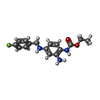+Search query
-Structure paper
| Title | Structural Basis for the Modulation of Human KCNQ4 by Small-Molecule Drugs. |
|---|---|
| Journal, issue, pages | Mol Cell, Vol. 81, Issue 1, Page 25-37.e4, Year 2021 |
| Publish date | Jan 7, 2021 |
 Authors Authors | Tian Li / Kun Wu / Zhenlei Yue / Yifei Wang / Fan Zhang / Huaizong Shen /  |
| PubMed Abstract | Among the five KCNQ channels, also known as the K7 voltage-gated potassium (K) channels, KCNQ2-KCNQ5 control neuronal excitability. Dysfunctions of KCNQ2-KCNQ5 are associated with neurological ...Among the five KCNQ channels, also known as the K7 voltage-gated potassium (K) channels, KCNQ2-KCNQ5 control neuronal excitability. Dysfunctions of KCNQ2-KCNQ5 are associated with neurological disorders such as epilepsy, deafness, and neuropathic pain. Here, we report the cryoelectron microscopy (cryo-EM) structures of human KCNQ4 and its complexes with the opener retigabine or the blocker linopirdine at overall resolutions of 2.5, 3.1, and 3.3 Å, respectively. In all structures, a phosphatidylinositol 4,5-bisphosphate (PIP) molecule inserts its head group into a cavity within each voltage-sensing domain (VSD), revealing an unobserved binding mode for PIP. Retigabine nestles in each fenestration, inducing local shifts. Instead of staying within the central pore, linopirdine resides in a cytosolic cavity underneath the inner gate. Electrophysiological analyses of various mutants corroborated the structural observations. Our studies reveal the molecular basis for the modulatory mechanism of neuronal KCNQ channels and provide a framework for structure-facilitated drug discovery targeting these important channels. |
 External links External links |  Mol Cell / Mol Cell /  PubMed:33238160 PubMed:33238160 |
| Methods | EM (single particle) |
| Resolution | 2.5 - 3.3 Å |
| Structure data | EMDB-30244, PDB-7byl: EMDB-30245, PDB-7bym: EMDB-30246, PDB-7byn: |
| Chemicals |  ChemComp-PT5:  ChemComp-K:  ChemComp-HOH:  ChemComp-FBX:  ChemComp-FCC: |
| Source |
|
 Keywords Keywords | MEMBRANE PROTEIN / KCNQ / Channel / Calmodulin / PIP2 / retigabine / linopirdine |
 Movie
Movie Controller
Controller Structure viewers
Structure viewers About Yorodumi Papers
About Yorodumi Papers









 homo sapiens (human)
homo sapiens (human)
